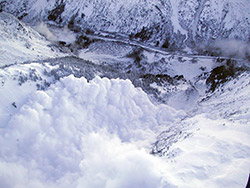Page Content
Avalanche
Every winter more and more adventurers head up to play in Canada's beautiful, snowy mountains. Remember that avalanches are possible in the mountains but also on hills. We commonly associate avalanche activity with the mountains of British Columbia and Alberta but they have also occurred in other parts of Canada including in Quebec and Newfoundland. You should always consider and be aware of the risks, how to stay safe, and how to act in the event of an avalanche incident. Are you avalanche aware?
Get Smart!
Essential winter survival skills for outdoor enthusiasts include the abilities to recognize and avoid avalanche terrain and effectively rescue a group member buried by an avalanche.
Prepare yourself by taking an Avalanche Skills Training Course (AST) with your friends. The site avalanche.ca provides a comprehensive range of valuable avalanche information, including a contact list of instructors-for-hire in your area who offer a two-day AST Level 1 course.
Want to learn about avalanche safety before your AST course starts up? Check out the Avalanche Canada online avalanche tutorial. This free online course won’t replace AST program field avalanche training, but it will teach you some basic avalanche first response skills in the meantime! Take the course and tell us what you think.
Want your kids to learn the basics of avalanche safety? Encourage your school to offer avalanche safety through the Snow Safety Education Program, the Survive Outside Snowmobile Program and the Survive Outside Program. Snow Safety Education is designed for school children in grades 4-6, and teaches the essentials of winter outdoor safety – in bounds and in the backcountry. Survive Outside Snowmobile is designed for children in grades 9-12 and adults, and teaches winter safety, and avalanche awareness, with a snowmobiling focus. Survive Outside is designed for children in grades 6-12 and adults, focusing on the the 3 T’s: trip planning, training and taking the essentials with additional avalanche awareness components when requested.
Before you go
Plan your trip and take into account current conditions. Do you have the proper clothing and equipment? How will you get home safely if the weather changes? Get the avalanche bulletin and weather forecast. If there is no avalanche bulletin available for your area, check out the avalanche safety discussion board at avalanche.ca/blogs.
Leave a trip plan with a friend of family member with details such as your itinerary, information for each group member, a description of your snowmobile (if necessary), and all other important information listed on the Trip Planning page.
While you’re out there
Carry and practice with essential gear—an avalanche transceiver, probe and shovel. Consider carrying the recommended gear—airbags, a helmet, RECCO and releasable bindings.
Be aware
Watch for signs of avalanche terrain en route to your destination. If you see small avalanches on small slopes, chances are the same conditions exist on larger slopes. You don’t have to head home; instead, simply head to a safer area. Sound judgment and knowing when to save it for another day are key survival skills.



